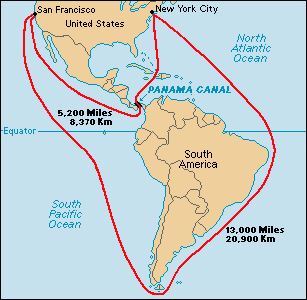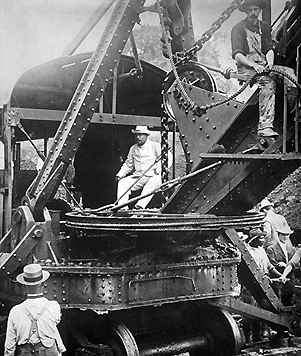A Man, A Plan, A Canal—100 Years Later
August 15, 2014
The Panama Canal, a waterway that cuts across the Isthmus of Panama and links the Atlantic Ocean and the Pacific Ocean, opened 100 years ago today. When the canal was completed in 1914, it shortened a ship’s voyage between New York City and San Francisco to less than 5,200 miles (8,370 kilometers). Previously, ships making the trip had to travel around South America—a distance of more than 13,000 miles (20,900 kilometers).

The Panama Canal cuts the trip from New York City to San Francisco by about 9,000 miles (14,400 kilometers). (World Book map)
Work on the Panama Canal was begun by the French in the 1880′s. After a few years, however, they stopped the project. They had lost nearly 20,000 workers to endemic diseases, mostly yellow fever and malaria.
Teddy Roosevelt became president in 1901 and immediately wanted to start building a canal across Panama. The political and engineering challenges were still formidable, but the timing was better for disease control. Since the 1880′s, scientists had learned that both yellow fever and malaria were transmitted by mosquitoes.

President Theodore Roosevelt visited the construction site of the Panama Canal in 1906. He wrote his son about the Gaillard Cut, saying, "They are eating steadily into the mountain ... ." (Bettmann Archive.)
Steps taken to defeat these two dread diseases in Panama included draining standing water or covering standing water with kerosene to prevent mosquitoes from laying eggs; and heavily spraying areas with insecticide to kill adult mosquitoes.
Work began on the canal in 1904 and it was completed in 1914. Worker deaths on the project the second time around were still very high—6,000 Americans died building the canal.
When the canal opened, approximately 1,000 ships a year passed through it. Today, some 15,000 ships a year pass through the canal.
Additional World Book articles:
- Building and Construction 2012 (a Back in Time article)
- Panama 2009 (a Back in Time article)


